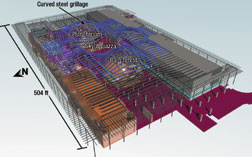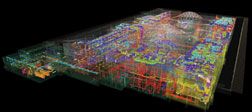At times, Jean Rogers felt as if she was herding cats. As sustainability consultant for the 410,000-sq-ft California Academy of Sciences replacement museum in San Francisco, it was her job to not only push the envelope of green building but to get the building team and exhibit designers to think outside the box. “There’s resistance everywhere, and you have to have patience, ask questions about why not and not take no for an answer,” says Rogers, an environmental engineer with the local office of Arup.

Webcor & California Academy of Sciences
Roof steel rides over exhibit hall domes and also forms five smaller “hills.”
|
 Webcor & California Academy of Sciences
Computer model rendered sustainable infrastructure more comprehensible to builders.
|
Patrick Kociolik, academy director from 1997-2006 and the visionary behind the academy’s green reinvention, understands Rogers’ take. “In 2000, none of us understood what a commitment to being green meant,” he says.
But by 2003, without even trying for it, the academy realized it was just two points away from the highest rank of the Leadership in Energy and Environmental Design green building rating system. At that stage the board of trustees voted to go for the top: platinum.
That ambition helped Kociolik run interference for Rogers. “When the contractor was over budget and wanted to reduce green aspects, I was able to say we would not step back from platinum,” says Kociolik.
At times, it was not easy to figure costs directly going to green elements. For example, the vented roof hills allow natural ventilation in the exhibit hall. “Do you attribute the cost of the hills to design or sustainability?” asks Kociolik.
On the construction side, Rogers hails Matt Rossie of San Mateo, Calif.-based general contractor Webcor Builders as her green champion. Rossie kept track of what percentages of building materials were local, recycled and renewable. “He personally took it on himself to exceed LEED numbers,” Rogers says.
The numbers are staggering, even for demolition waste from the old buildings: Contractors recycled more than 90% of waste. This included 9,000 tons of concrete for roadway construction and 12,000 tons of steel.
The building, a pilot green project for the city, has already garnered two awards for its sustainable systems and it is not even open yet.

Post a comment to this article
Report Abusive Comment